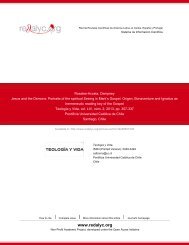A Key Concept in Modern Translation Theory - Redalyc
A Key Concept in Modern Translation Theory - Redalyc
A Key Concept in Modern Translation Theory - Redalyc
You also want an ePaper? Increase the reach of your titles
YUMPU automatically turns print PDFs into web optimized ePapers that Google loves.
SERGIO BOLAÑOS CUELLAR<br />
79<br />
communicative, textual, cognitive, and with regard to the translator, translation<br />
competence), participants’ socio-psychological characterization (gender, age, role,<br />
status; motivation, <strong>in</strong>terest, memory, etc.), and context (historic, economic, social,<br />
cultural). The text corresponds to the l<strong>in</strong>guistic realization of the communicative<br />
purpose of the sender <strong>in</strong> L1). It is structured <strong>in</strong> the follow<strong>in</strong>g <strong>in</strong>terwoven levels:<br />
(stylistic) syntactic (cohesion mechanisms such as references, connectors,<br />
substitutions, etc), (stylistic) lexical (l<strong>in</strong>guistic variety: sociolect, dialect, jargon, etc),<br />
semantic (coherence mechanisms: time sequence, topic sequence, argument;<br />
presupposition, <strong>in</strong>ference; denotation, connotation), pragmatic (speech acts:<br />
performative, constative; direct/ <strong>in</strong>direct); sender’s <strong>in</strong>tention (illocution) and <strong>in</strong>tended<br />
effect (perlocution), and semiotic (comb<strong>in</strong>ation of verbal and non-verbal signs <strong>in</strong><br />
SL-Text: diagrams, tables, charts, etc.).<br />
Let’s see briefly how the model works. The potential <strong>in</strong>itiator of the translation<br />
process is a client. If there is no client, the translator himself can start the process<br />
of translat<strong>in</strong>g an SL-text <strong>in</strong>to a TL. The SL-text’s sender and/or author wishes to<br />
fulfill some communicative purpose <strong>in</strong> his speech community. The translator should<br />
be aware of the communicative value of SL-text and its closest equivalent <strong>in</strong> L2.<br />
Accord<strong>in</strong>g to the different conditions and determ<strong>in</strong>ants, the sender fulfills some<br />
specific role when he produces the source language text. He can be a father, a<br />
club member, a scientist, etc. Let’s assume he decides to write a scientific text.<br />
In this case his most relevant social characterization is the role he plays as a<br />
scientist. There will be a potential community of receivers who belong to the<br />
same scientific field, to whom the text is basically addressed. They would be the<br />
first addressees of the text, that is, the text has been articulated <strong>in</strong> such a way<br />
that it is these readers who can work out most profitably the conveyed content<br />
of the message.<br />
The translator <strong>in</strong> charge of translat<strong>in</strong>g this text should possess the l<strong>in</strong>guistic<br />
and communicative, and textual competences for the <strong>in</strong>itial read<strong>in</strong>g of the text.<br />
Afterwards, as the text deals with a specialized topic, the translator activates his<br />
cognitive competence <strong>in</strong> order to update and contrast his previous knowledge<br />
with the knowledge that is be<strong>in</strong>g presented <strong>in</strong> the text (cf. scheme-script-frame<br />
theories, He<strong>in</strong>emann/Viehweger 1981:71) Thus he can fully understand the text’s<br />
mean<strong>in</strong>g. Now he activates his translation competence, which will allow him to<br />
carry out a read<strong>in</strong>g we have called ‘surgical’, which consists <strong>in</strong> read<strong>in</strong>g the text<br />
once aga<strong>in</strong> <strong>in</strong> order to determ<strong>in</strong>e the way it has been constructed <strong>in</strong> relation to<br />
the stylistic syntactic and lexical characteristics, as well as the semantic, pragmatic<br />
and semiotic peculiarities, which may prove potentially problematic for the<br />
translation process. At this po<strong>in</strong>t a first draft of the translation is prepared tak<strong>in</strong>g
















